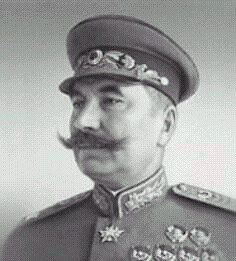Semyon Budyonny
|
|
Semyon Mikhailovich Budyonny (also spelled Budennii, Budenny, Budyenny etc, Russian: Семён Михайлович Будённый) (April 25, 1883 - October 26, 1973) was a Soviet military commander and an ally of Soviet leader Joseph Stalin. He had been over-promoted, filling the place of men suspected by Stalin of being opposed to his rule.
Budyonny was born into a poor peasant family in the Don Cossack region of southern Russia. He worked as a farm laborer until 1903, when he was drafted into the army of the Russian Empire, becoming a cavalryman and serving in the Russo-Japanese War of 1905. During World War I he was a non-commissioned officer on the western front until 1916, when he was transferred to the Caucasus front. When the Russian revolution over threw the Tsarist regime in 1917, he was radicalized like many soldiers and became a leading member of the soldiers' councils (Soviets) in the Caucasus area.
Civil War broke out in 1918, and Budyonny organised a Red Cavalry force in the Don region, which eventually became the 1st Cavalry Army. This Army played an important role in winning the Civil War for the Bolsheviks, driving the White General Anton Denikin back from Moscow. Budyonny joined the Bolshevik party in 1919, and formed close relationships with Joseph Stalin and Kliment Voroshilov.
In 1920 Budyonny's Cavalry Army took part in the invasion of Poland in the Polish-Bolshevik War, in which it was quite successful at first, pushing Polish forces out of Ukraine and later breaking through Polish southern frontlines. However later the Bolsheviks forces sustained a heavy defeat in the Battle of Warsaw, mainly because Budyonny's Army was bogged down at Lwów. After his army was defeated in the Battle of Komarów (one of the biggest cavalry battles of the world), Budyonny was then sent south to fight the Whites in Ukraine and the Crimea. Despite the defeat in Poland, he was one of Soviet Russia's military heroes by the end of the Civil War.
Budyonny was considered a courageous and colorful cavalry officer, but knew little about modern warfare, particularly the impact of tanks. He was appointed to the position of Cavalry Inspector of the Red Army and similar honorific posts, and remained one of Stalin's "Civil War cronies" who held increasing influence as Stalin consolidated himself as the unquestioned dictator of the Soviet Union.
In 1935 Budyonny was made one of the first five Marshals of the Soviet Union. Three of these five were executed in the Great Purge of the late 1930s, leaving only Budyonny and Voroshilov. This left the Soviet Union dangerously short of capable commanders when World War II broke out. In 1937 Budyonny commanded the Moscow Military District, and in the Soviet-Finnish War he commanded an army, with disastrous results. Nevertheless, in 1940 Budyonny was made Deputy People's Commissar for Defense, a position for which he was quite unsuited.
In 1941, Budyonny was put in charge of the Southwestern Front, facing the German invasion of Ukraine which began in June. He had the Red Army's best divisions under his command and great superiority of numbers, but allowed himself to be surrounded, first at Uman and then at Kiev. These disasters cost the Soviet Union 1.5 million men killed or taken prisoner, one of the greatest routs in military history.
In September, Stalin finally dismissed Budyonny and replaced him with Semyon Timoshenko. He was placed in charge of the Reserve Front and later of the obsolete Soviet Cavalry. Despite being responsible (although acting on Stalin's orders) for catastrophic Soviet defeats, he continued to enjoy Stalin's patronage and suffered no punishment, while other generals were shot or sent to gulags for defeats far less severe. After the war he was allowed to retire as a Hero of the Soviet Union.
Template:Wikiquotede:Semjon Michailowitsch Budjonny pl:Siemion Budionny ru:Будённый, Семён Михайлович sl:Semjon Mihajlovič Budjoni fi:Semjon Budjonnyi

